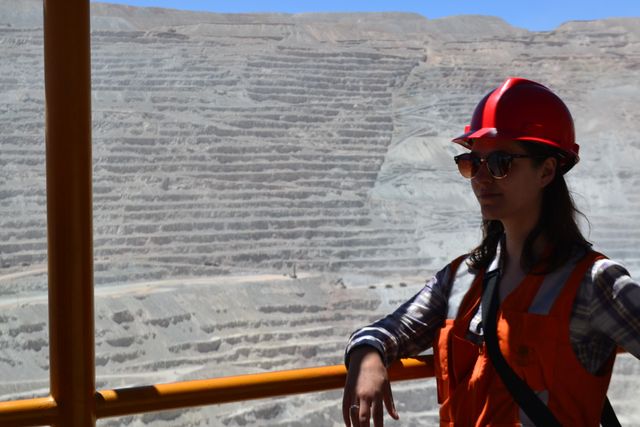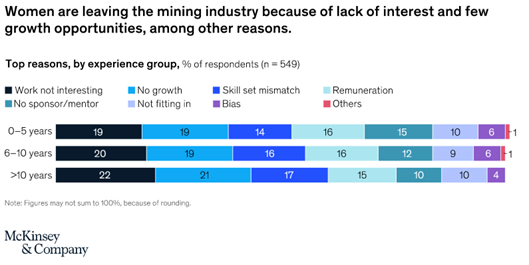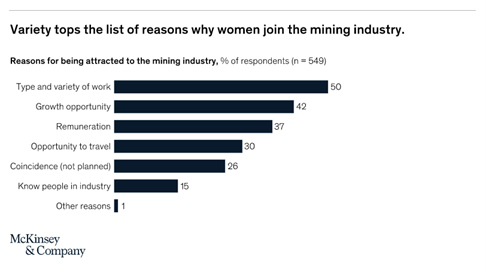
A new report from McKinsey shows women are leaving the mining industry. But why? And what can we do about it?
Women are leaving the mining industry because the work isn’t interesting, they’re not being given opportunities to grow, or because it’s a mismatch for their skills.
That’s according to new research from the analysts at McKinsey & Company, who also found not fitting in, bias, remuneration levels and the lack of mentors or sponsors were key reasons for women departing the mining industry globally.
Here’s what they found:

What’s pushing women out of mining?
McKinsey’s report found eight to 17% of the global mining workforce were women, which it considered a low participation rate. The drop-off from entry-level to executive roles for women was, compared to other industries, “dramatic”—with female representation within mining company C-suites at just 13% globally and not a single female CEO of an S&P 500 mining company.
McKinsey interviewed more than 1000 women for their report and found women had left (or wanted to leave) the industry because the qualities that had originally attracted them to the field no longer existed.
- They no longer felt the work was intellectually challenging
- They perceived fewer advancement opportunities for them than their male colleagues
- They felt sidelined, particularly for technical roles, and unable to access “stepping stone” operational roles
- Opportunities to gain experience or to be mentored are proactively created for men while women are expected to gain frontline experience “elsewhere”
- They felt their academic skills were undervalued.
Mining’s blokey culture is also a problem
But it doesn’t stop there. McKinsey found company culture and a lack of diversity beyond the entry level were also factors pushing women out of mining. McKinsey quoted one respondent who said: “It takes a lot of effort to be the ‘diverse one’ at the table.”
McKinsey’s researchers found the women surveyed commonly referred to “not being a member of the boys’ club”, which lowered their motivation and sense of belonging.
“Women can find it twice as hard as men (44% versus 23%) to adapt to the culture of the mining industry,” the report said. “Multiple factors influence the culture in the sector, including leadership role modelling, biases (including gender bias and unconscious bias), company policies and contractors.
“Respondents who perceived their company culture as not supporting diversity were twice as likely to want to leave as those who felt their company was balanced.”
What can the mining industry do to be more welcoming to women?
The report authors suggest a three-pronged approach to make the mining industry more attractive to women.
- Attraction
- Retention
- Promotion
Attraction
McKinsey suggests setting a goal of parity in recruitment targets (i.e., 50% women). It also recommends cultivating potential applicants early, at university or even at high school. Lastly, it also suggests ensuring women are properly “buddied” with a current employee, so they feel supported.

Retention
Given the reasons for women departing the industry (noted above), McKinsey recommends:
- Ensuring advancement opportunities for women
- Creating rotational programs across business units, functions, and geographies, to provide a diversity of experience and stimulation
- Working hard on your company culture and providing facilities and services to ensure the specific needs of women are catered for (e.g., women-only washrooms, zero-tolerance discrimination policies).
Promotion
McKinsey highlighted the importance of providing sponsorship and mentorship opportunities for female talent. This ensures that when leadership positions come up, there are qualified women ready to be considered in the recruitment process.
Some mining companies already working hard to supporting women
McKinsey’s report has a global focus, and while the concerns and strategies raised certainly have relevance and an application to the Australian mining industry, it’s worth noting here that many mining companies are already working hard to support female employees and provide opportunities for women.
For example, in June 2021, Mineral Resources welcomed its second all-female intake as part of its regular entry-level operator recruitment program.
At the same time, the company joined the National Association for Women in Operations—a not-for-profit that aims to see gender diversity valued and balanced at every level of operations.
Mineral Resources’ General Manager of Human Resources and Industrial Relations Layla Mehravari told Australian Mining the company hadn’t set out to hold all-female intakes, but found “it was just the push some participants needed to get a start in the mining industry”.
“These are broad programs in that we bring anybody who’s new to the industry through the door,” she said. “But we were having a lot of successful female applicants come through, so we went through the process of aligning intakes with whole female groups to create a nice cohort and community.
“This was important because a big challenge is getting that critical mass of women on remote sites with a sense of community among themselves.”
Mineral Resources has now lifted its female employment level above the industry average of 16.1%.
What’s the state of women’s inclusion in Australian mining?
While there’s certainly still work to do (recent news stories about sexual harassment in the industry are evidence of that) it’s also worth looking at some Australia-specific data relating to women in mining.
The AusIMM Women in Mining Survey looked at women’s participation and experiences in the mining industry. Here’s what it found:
- Women still report that their own workplaces are significantly more inclusive than their perception of the broader resources sector
- Amenities are improving, with 67% of female respondents rating amenities as good or very good, an increase of 7.5% on previous years
- Travel support is improving, with 73% of female respondents rating employer support for travel as good or very good, an increase of 10% on previous years
- Aboriginal and Torres Strait Islander women in resources are five times more likely to have high school graduation as their highest form of qualification, compared to the survey average
- Leadership is rated by 79% of women in resources as being a top priority for diversity and inclusion in the sector, and is identified as a key professional development priority by 55% of respondents
- The onsite experience is improving for many women in resources, but workforce flexibility and support to manage inter-role conflict continue to be key challenges.
So, the AusIMM report indicates lots of good work has already been done in the Australian mining sector. Keeping on the right trajectory, though, means listening to the findings of reports like McKinsey’s, learning the lessons, and creating more opportunities for women.
Mining People has more than 26 years’ specialist experience helping mining companies find the best candidates across every job category. Get in touch today.